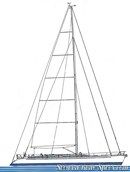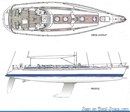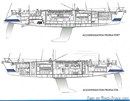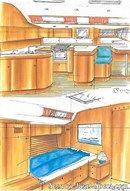X-612 Shoal draft
Sailboat specifications
The X-612 is a 60’ (18.29m) racer-cruiser sailboat designed by Niels Jeppesen (Denmark). She was built between 1995 and 2004 by X-Yachts (Denmark) with 12 hulls completed. The Shoal draft version features a shorter keel to grant access to shallow areas.
The X-612 is as well listed, on Boat-Specs.com, in Standard version (see all the versions compared).
The X-612 is as well listed, on Boat-Specs.com, in Standard version (see all the versions compared).
X-612's main features
- Model
- X-612
- Version
- Shoal draft
- Hull type
- Monohull
- Category
- Offshore racer-cruiser sailboat
- Sailboat builder
- Sailboat designer
- Country
- Denmark
- Construction
- GRP (glass reinforced polyester):
Sandwich fiberglass polyester with galvanized steel frame - Number of hulls built
- 12
- First built hull
- 1995
- Last built hull
- 2004
- Appendages
- Keel : fin with bulb
- Helm
- Twin helm wheels
- Rudder
- Single semi-spade rudder
- Unsinkable
- No
- Trailerable
- No
- Standard public price ex. VAT (indicative only)
- N/A €
X-612's main dimensions
- Hull length
- 60’18.29 m
- Waterline length
- 53’16.15 m
- Beam (width)
- 16’ 8”5.1 m
- Draft
- 7’ 2”2.2 m
- Light displacement (MLC)
- 42990 lb19500 kg
- Ballast weight
- 20062 lb9100 kg
- Ballast type
- Cast iron fin with lead bulb
X-612's rig and sails
- Upwind sail area
- 2310 ft²214.6 m²
- Downwind sail area
- 3922 ft²364.4 m²
- Mainsail area
- 935 ft²86.9 m²
- Genoa area
- 1375 ft²127.7 m²
- Solent area
- 916 ft²85.1 m²
- Jib area
- 517 ft²48 m²
- Symmetric spinnaker area
- 2987 ft²277.5 m²
- IiFore triangle height (from mast foot to fore stay top attachment)
- 78’ 2”23.85 m
- JiFore triangle base (from mast foot to bottom of forestay)
- 22’ 7”6.9 m
- PiMainsail hoist measurement (from tack to head)
- 70’ 11”21.6 m
- EiMainsail foot measurement (from tack to clew)
- 23’7 m
- Rigging type
- Sloop Marconi masthead
- Mast configuration
- Keel stepped mast
- Rotating spars
- No
- Number of levels of spreaders
- 3
- Spreaders angle
- 0 °
- Spars construction
- Aluminum spars
- Standing rigging
- Single-strand (ROD) discontinuous
X-612's performances
- Upwind sail area to displacementiThe ratio sail area to displacement is obtained by dividing the sail area by the boat's displaced volume to the power two-thirds.
The ratio sail area to displacement can be used to compare the relative sail plan of different sailboats no matter what their size.
Upwind: under 18 the ratio indicates a cruise oriented sailboat with limited performances especially in light wind, while over 25 it indicates a fast sailboat. - 319 ft²/T29.62 m²/T
- Downwind sail area to displacementiThe ratio sail area to displacement is obtained by dividing the sail area by the boat's displaced volume to the power two-thirds.
The ratio sail area to displacement can be used to compare the relative sail plan of different sailboats no matter what their size. - 541 ft²/T50.3 m²/T
- Displacement-length ratio (DLR)iThe Displacement Length Ratio (DLR) is a figure that points out the boat's weight compared to its waterline length. The DLR is obtained by dividing the boat's displacement in tons by the cube of one one-hundredth of the waterline length (in feet).
The DLR can be used to compare the relative mass of different sailboats no matter what their length:
a DLR less than 180 is indicative of a really light sailboat (race boat made for planning), while a DLR greater than 300 is indicative of a heavy cruising sailboat. - 131
- Ballast ratioiThe Ballast ratio is an indicator of stability; it is obtained by dividing the boat's displacement by the mass of the ballast. Since the stability depends also of the hull shapes and the position of the center of gravity, only the boats with similar ballast arrangements and hull shapes should be compared.
The higher the ballast ratio is, the greater is the stability. - 47 %
- Critical hull speediAs a ship moves in the water, it creates standing waves that oppose its movement. This effect increases dramatically the resistance when the boat reaches a speed-length ratio (speed-length ratio is the ratio between the speed in knots and the square root of the waterline length in feet) of about 1.2 (corresponding to a Froude Number of 0.35) . This very sharp rise in resistance, between speed-length ratio of 1.2 to 1.5, is insurmountable for heavy sailboats and so becomes an apparent barrier. This leads to the concept of "hull speed".
The hull speed is obtained by multiplying the square root of the waterline length (in feet) by 1.34. - 9.75 knots
X-612's auxiliary engine
- Engine(s)
- 1 inboard engine
- Engine(s) power
- 110 HP
- Fuel type
- Diesel
- Fuel tank capacity
- 211.3 gal800 liters
X-612's accommodations and layout
- Cockpit
- Closed aft cockpit
- Cabin(s)
- 4
- Berth(s) (min./max.)
- 7 / 9
- Head(s)
- 3
- Freshwater tank capacity
- 211.3 gal800 liters
- Fridge/ice-box capacity
- 84.5 gal320 liters
- Boiler capacity
- 10.6 gal40 liters







X-Yachts X-612 interior and accommodations - - 6/7
Picture extracted from the commercial documentation © X-Yachts
Picture extracted from the commercial documentation © X-Yachts


X-Yachts X-612 interior and accommodations - - 7/7
Picture extracted from the commercial documentation © X-Yachts
Picture extracted from the commercial documentation © X-Yachts
Similar sailboats that may interest you:
Sailboats
First built hull
Hull length
1988
52’ 6”16 m
2013
55’16.76 m
2012
63’19.2 m
2010
63’ 1”19.22 m
2004
50’15.24 m
2005
55’16.76 m
1995
60’18.29 m
2015
58’ 2”17.75 m
2016
63’19.19 m
2016
59’ 6”18.13 m
2009
61’ 11”18.86 m
2009
61’ 11”18.86 m
2017
50’ 11”15.51 m
2018
55’ 1”16.8 m
2007
62’ 11”19.18 m